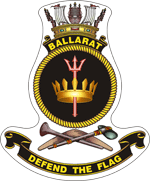HMAS Ballarat (J184)

HMAS Ballarat
|
|
| History | |
|---|---|
|
|
|
| Namesake: | City of Ballarat, Victoria |
| Builder: | HMA Naval Dockyard in Williamstown, Victoria |
| Laid down: | 19 April 1940 |
| Launched: | 10 December 1940 |
| Commissioned: | 30 August 1941 |
| Decommissioned: | 27 September 1946 |
| Motto: | "Defend the Flag" |
| Honours and awards: |
|
| Fate: | Sold into civilian service in 1947. Sold for scrap in 1953. |
| Badge: |  |
| General characteristics | |
| Class and type: | Bathurst-class corvette |
| Displacement: | 650 tons (standard), 1,025 tons (full war load) |
| Length: | 186 ft (57 m) |
| Beam: | 31 ft (9.4 m) |
| Draught: | 8.5 ft (2.6 m) |
| Propulsion: | triple expansion engine, 2 shafts, 1,750 horsepower |
| Speed: | 15 knots (28 km/h; 17 mph) |
| Complement: | 85 |
| Armament: |
|
HMAS Ballarat (J184), named for the city of Ballarat, Victoria, was one of 60 Bathurst-class corvettes constructed during World War II and one of 20 built for the Admiralty but manned by personnel of and commissioned into the Royal Australian Navy (RAN).
In 1938, the Australian Commonwealth Naval Board (ACNB) identified the need for a general purpose 'local defence vessel' capable of both anti-submarine and mine-warfare duties, while easy to construct and operate. The vessel was initially envisaged as having a displacement of approximately 500 tons, a speed of at least 10 knots (19 km/h; 12 mph), and a range of 2,000 nautical miles (3,700 km; 2,300 mi) The opportunity to build a prototype in the place of a cancelled Bar-class boom defence vessel saw the proposed design increased to a 680-ton vessel, with a 15.5 knots (28.7 km/h; 17.8 mph) top speed, and a range of 2,850 nautical miles (5,280 km; 3,280 mi), armed with a 4-inch gun, equipped with asdic, and able to fitted with either depth charges or minesweeping equipment depending on the planned operations: although closer in size to a sloop than a local defence vessel, the resulting increased capabilities were accepted due to advantages over British-designed mine warfare and anti-submarine vessels. Construction of the prototype HMAS Kangaroo did not go ahead, but the plans were retained. The need for locally built 'all-rounder' vessels at the start of World War II saw the "Australian Minesweepers" (designated as such to hide their anti-submarine capability, but popularly referred to as "corvettes") approved in September 1939, with 60 constructed during the course of the war: 36 ordered by the RAN, 20 (including Ballarat) ordered by the British Admiralty but manned and commissioned as RAN vessels, and 4 for the Royal Indian Navy.
...
Wikipedia
